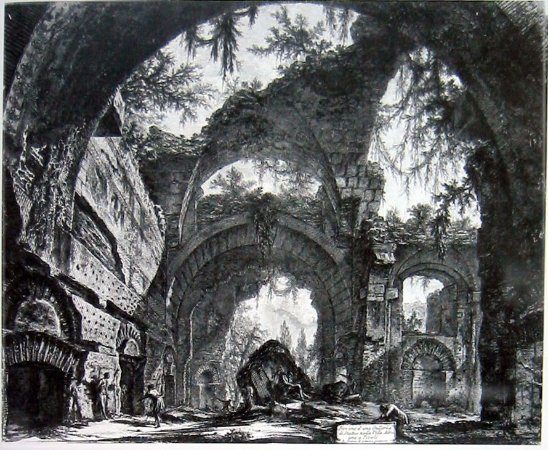{:it}Giovanni Battista Piranesi exhibition in Pesaro: "The dream of classicism"
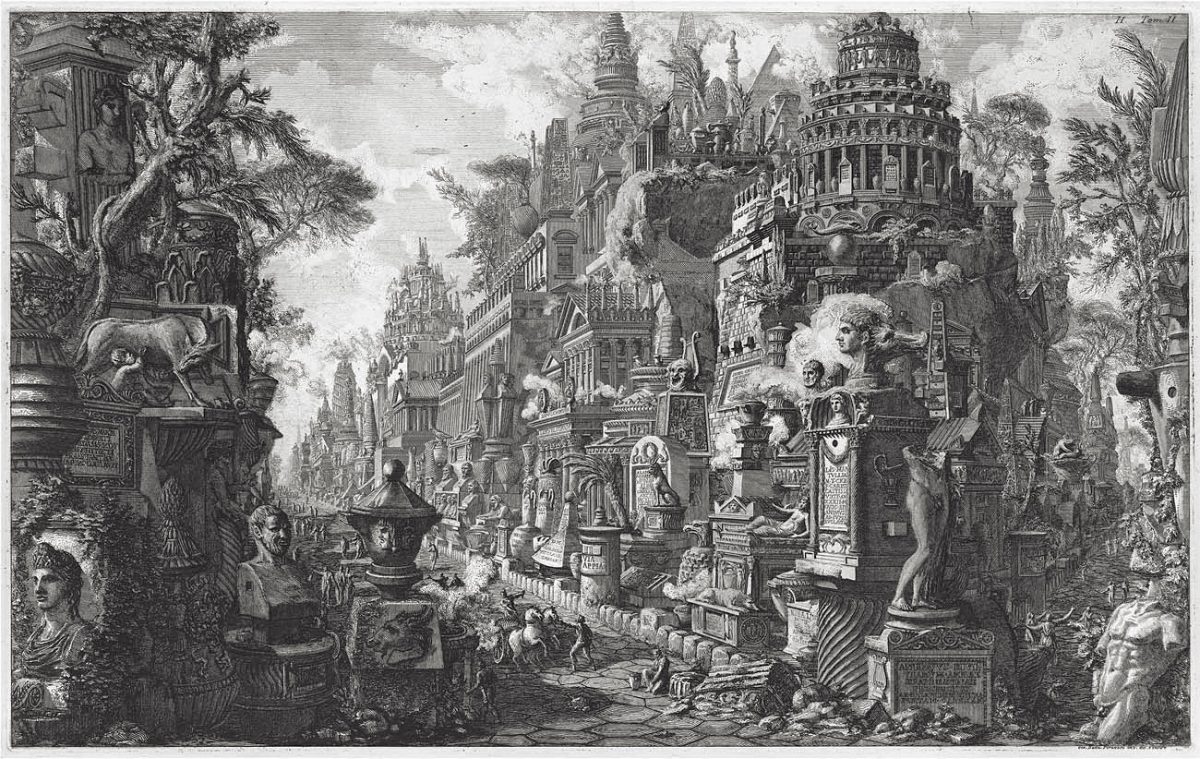 “The black mind of Piranesi” says Victor Hugo in his passage. The works of the great eighteenth-century engraver, interpreter of the tragic beauty of Rome, can be admired until 8 April 2018 in the rooms of Palazzo Mosca, Civic Museums of Pesaro.
“The black mind of Piranesi” says Victor Hugo in his passage. The works of the great eighteenth-century engraver, interpreter of the tragic beauty of Rome, can be admired until 8 April 2018 in the rooms of Palazzo Mosca, Civic Museums of Pesaro.
A journey through time and space through the ruins of the ancient city engraved by the man who called himself "architectus venitianus" but who, once he arrived in the capital, was completely captivated by those romantic visions of temples and ancient statues half abandoned in the fields towards which he had an entirely Goethean feeling of making himself useful by preserving his memory. His works, however, extremely suggestive and romantic, seem to warn us of an ever-imminent danger and therefore also appear fatal, not to mention disturbing.
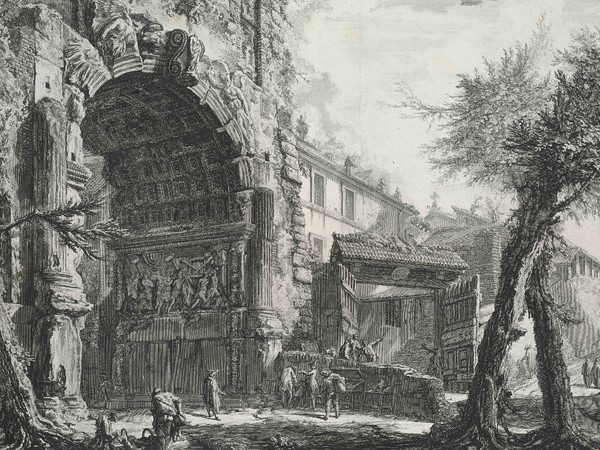
Among the ruins you can see crippled people, horrible hunchbacks who have the appearance of having no fixed abode other than inhabitants of those stone and brick wrecks, a worthy environment for those beggars, and also skulls and sarcophagi, dogs that bite and tear each other, sheep who graze, rags among the bushes, what remains of an empire that dominated the world, to highlight that human condition that continually changes and in whose destiny everyone is ascribed, even the powerful.
The sense of decadence also concerns himself, his life as an architect always looking for work, an antiques dealer and an engraver, forced into different professions in a Rome steeped in popery, strong in his power which is concentrated around him and which leaves no escape , the message is full of warnings, the turning wheel ultimately concerns everyone, even those in power.
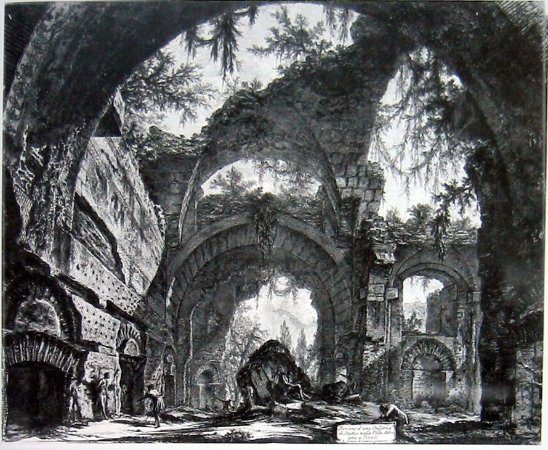
In the Pesaro exhibition, the works of the artist-architect flow through the different rooms of the museum, some admirable on a human scale, others unfortunately placed too high to prevent a correct and careful viewing, which is truly a shame.
However, it is worth a visit, if only to admire the video on the famous "Invention Prisons" created by Gregoire Dupont for the Giorgio Cini Foundation in Venice, where one is absorbed by his imaginative world which refers to the Venetian Piombi and a entirely metastasized anguish of the human condition; the nightmare from which one cannot escape, Hell, the Judgment or the Dies Irae dear to subsequent Gothic novels.
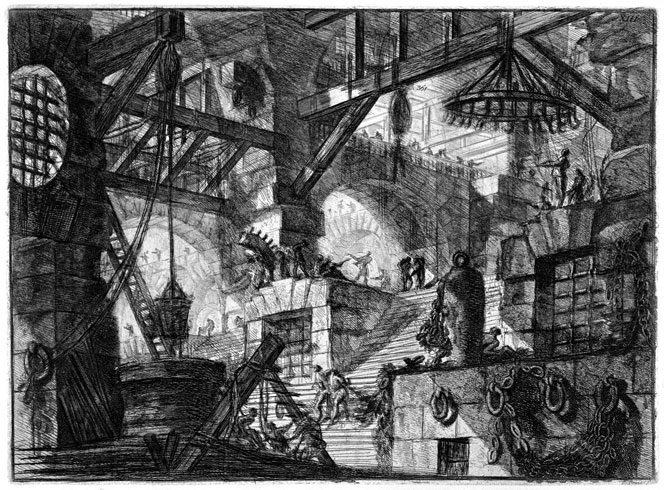 Immersing yourself in its entrance halls, climbing those stairs, it seems to enter the cavities of the mind of this artist worn out by fatigue, passionate and careless of his health, who ate only cold rice during long stays in the malaria-infested Roman countryside.
Immersing yourself in its entrance halls, climbing those stairs, it seems to enter the cavities of the mind of this artist worn out by fatigue, passionate and careless of his health, who ate only cold rice during long stays in the malaria-infested Roman countryside.
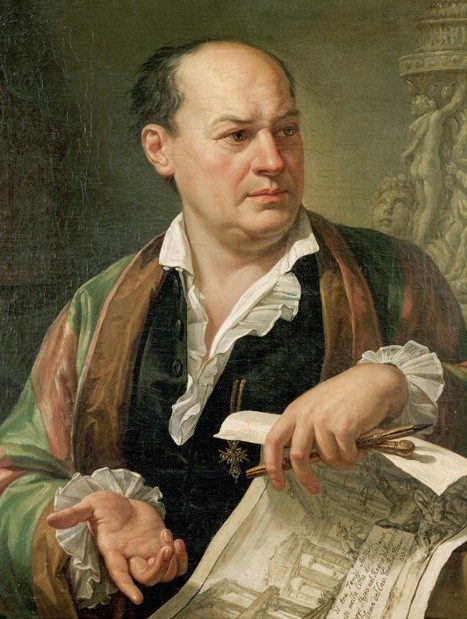
Piranesi's genius is expressed in his mastery and his ability to disseminate, by marrying the lithography technique he was able to print hundreds of copies of his drawings, the result of immense work, engraving them on zinc plates, without however altering their beauty. In this sense, Piranesi's art was truly modern and capable of leaving its "sign", which is the precondition for immortality.
“Giambattista Piranesi, the dream of classicism” – 8 December 2017, 8 April 2018. Pesaro, Palazzo Mosca Musei Civici, piazza Toschi Mosca 29- www.pesaromusei.it{:} {: en}
“The black brain of Piranesi” wrote Victor Hugo. The works of the great engraver of the Eighteenth century and commentator of the tragic beauty of Rome can be seen at Palazzo Mosca, Municipal Museums (Musei Civici) in Pesaro until April, 8 2018.
 A time and space travel through the ancient Roman ruins, engraved by the artist who used to describe himself as “architectus venetianus (latin for Venetian architect)”, but it was when he moved to Rome that he was hit by romantic visions of the ancient temples and statues almost abandoned across the fields. Those ruins raised a Goethean feeling in him, i.e. the usefulness of keeping their memory. His works were extremely suggestive and romantic, it seems like they warn of a forthcoming danger, so that they appear even menacing, or disturbing.
A time and space travel through the ancient Roman ruins, engraved by the artist who used to describe himself as “architectus venetianus (latin for Venetian architect)”, but it was when he moved to Rome that he was hit by romantic visions of the ancient temples and statues almost abandoned across the fields. Those ruins raised a Goethean feeling in him, i.e. the usefulness of keeping their memory. His works were extremely suggestive and romantic, it seems like they warn of a forthcoming danger, so that they appear even menacing, or disturbing.
 Among the ruins you can catch sight of cripple and horrible hunch-backed figures, that look like homeless or maybe their home is the stone and brick ruin; the right place for those beggars; some skulls and sarcophaguses, biting and delousing dogs, grazing sheep, rags on the bushes, finally what is left of an empire that used to rule the world. The scenery highlights the always-changing human condition, in which everyone – including the mighty people – accepts destiny.
Among the ruins you can catch sight of cripple and horrible hunch-backed figures, that look like homeless or maybe their home is the stone and brick ruin; the right place for those beggars; some skulls and sarcophaguses, biting and delousing dogs, grazing sheep, rags on the bushes, finally what is left of an empire that used to rule the world. The scenery highlights the always-changing human condition, in which everyone – including the mighty people – accepts destiny.
 The feeling of decay applies also for the artist himself, his architect's life always looking for a job, antique dealer and engraver, forced to change several jobs in a time where Rome was ruled by powerful popes, strong and with no way out. The message is dense in warnings; the metaphorical and turning circle on the background refers to everyone's lives, even to mighty people.
The feeling of decay applies also for the artist himself, his architect's life always looking for a job, antique dealer and engraver, forced to change several jobs in a time where Rome was ruled by powerful popes, strong and with no way out. The message is dense in warnings; the metaphorical and turning circle on the background refers to everyone's lives, even to mighty people.
At Pesaro's exhibition you can look at the works of the architect and man of Arts, some of them are people-oriented while others are located too high for a proper and careful viewing, and that is a real pity.
It is well worth a visit, if only for the video about the famous “Imaginary Prisons” made by Gregoire Dupont for the Venetian Fondazione Giorgio Cini, where you are absorbed by his imaginary world that reminds of The Venetian Leads (Piombi is an ancient prison in Venice) and a Metastasian angst of the human condition. It's like a nightmare you cannot get out of, an Inferno that never ends, the Judgment or the “Dies Irae (latin for The Last Judgement)” that would later become a leitmotif in Gothic novels. Losing yourself in those entrance halls, climbing the stairs, it seems like entering the holes of the brain of this artist who was worn out by struggles, but still passionate and unconcerned about his own health, his main dish was cold rise during the long stay in the malarial Roman countryside.
 Piranesi's genius shows in his expertise and educational talent, he used the lithographic technique to print hundreds of copies of his own drawings, engraved on zinc slabs, keeping intact their original beauty. In this case, Piranesi's art was modern and able to leave a “sign”, that is actually the precondition to immortality.
Piranesi's genius shows in his expertise and educational talent, he used the lithographic technique to print hundreds of copies of his own drawings, engraved on zinc slabs, keeping intact their original beauty. In this case, Piranesi's art was modern and able to leave a “sign”, that is actually the precondition to immortality.
Visit the Exhibition “Giambattista Piranesi, the dream of classicism” from December, 8 2017 until April, 8 2018 in the City of Pesaro, Piazza Toschi Mosca 29, at Palazzo Mosca, Municipal Museums (Civic Museums), www.pesaromusei.it{:}

